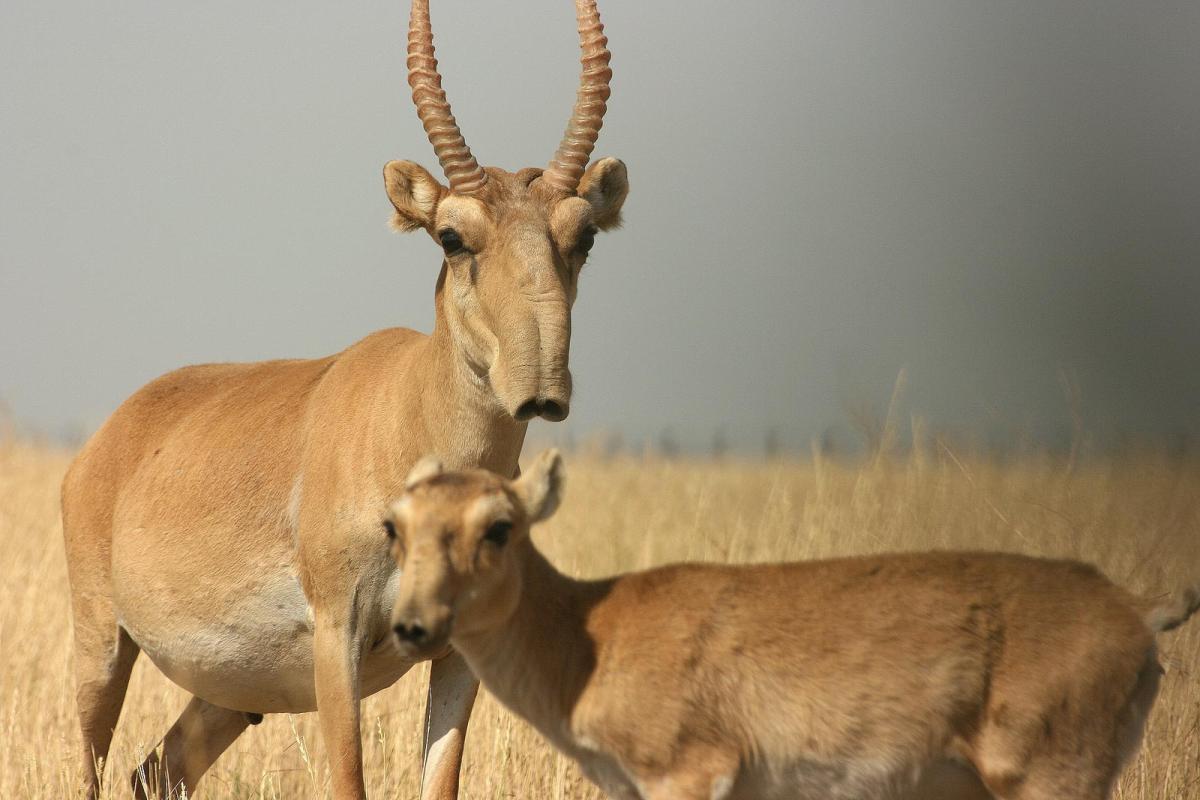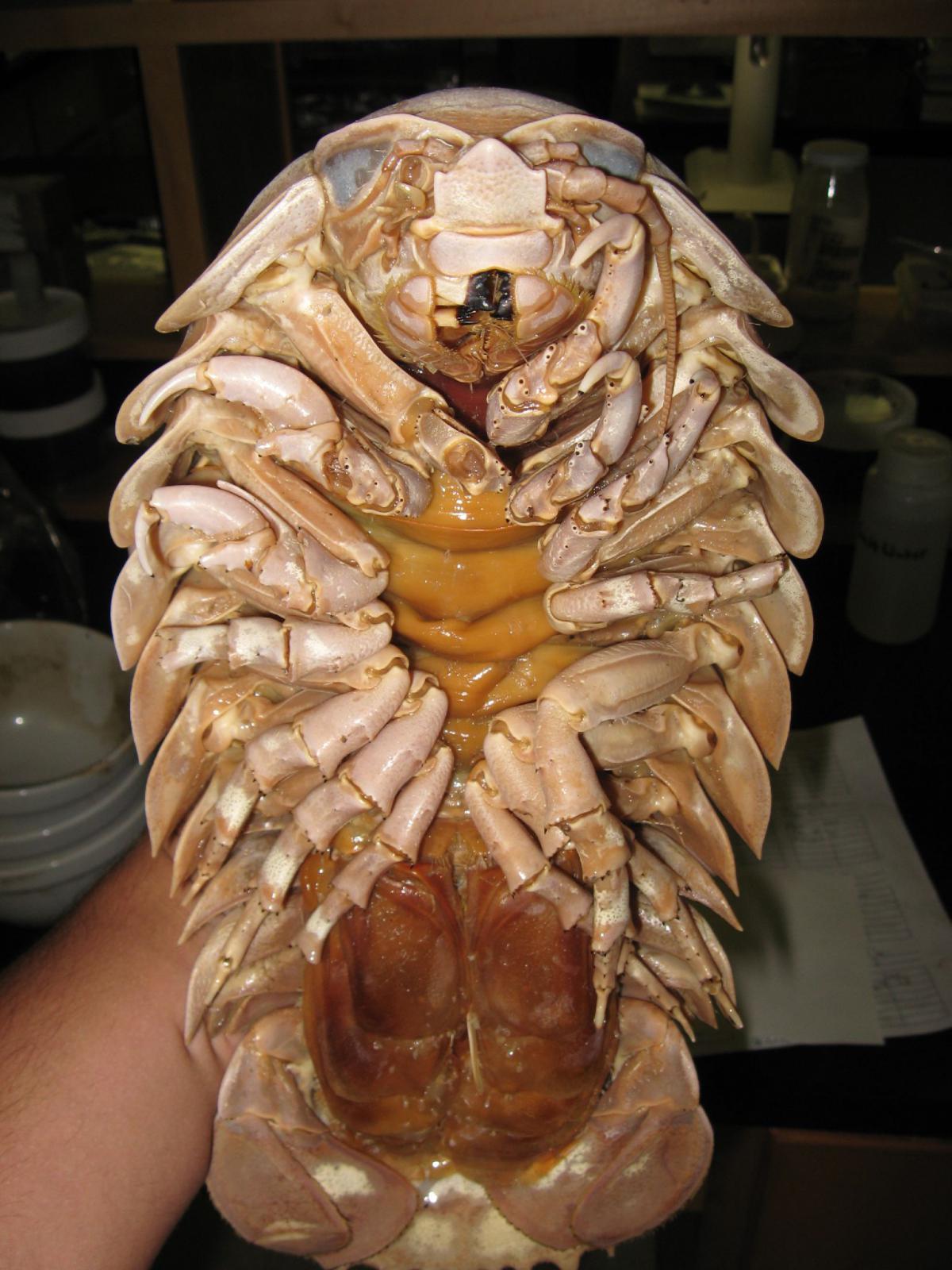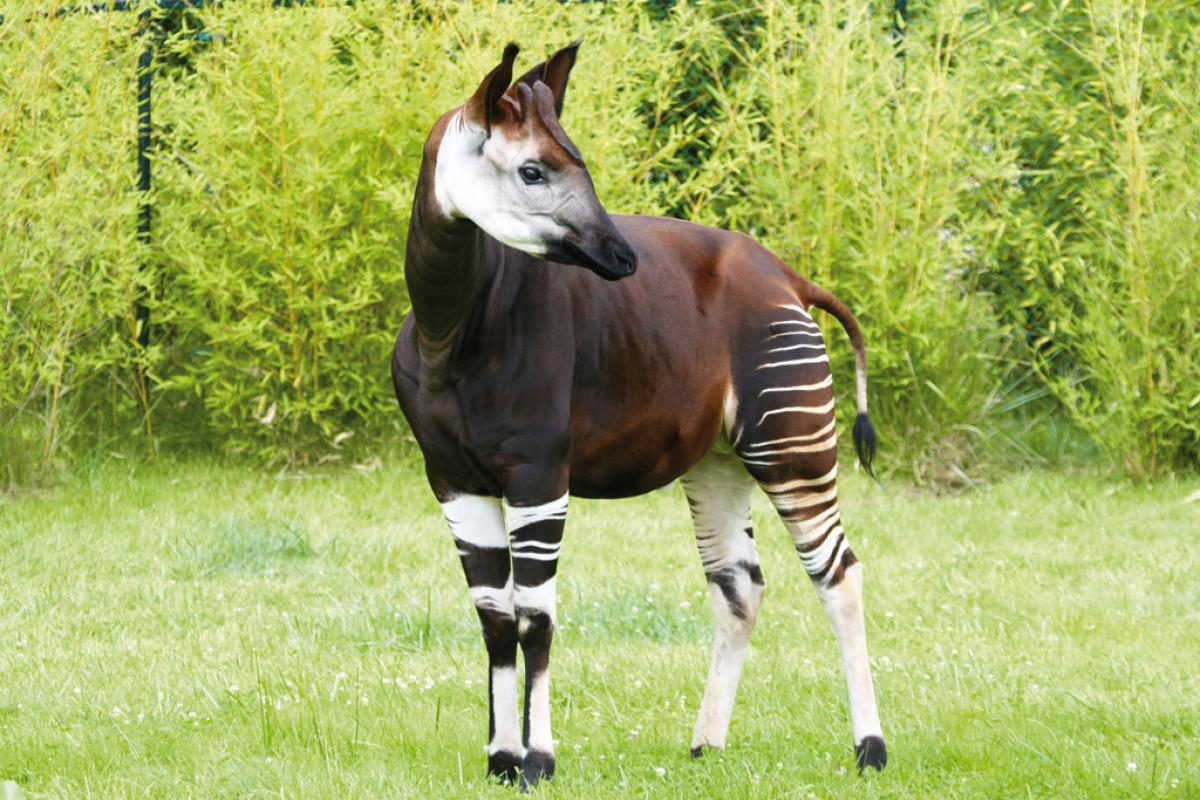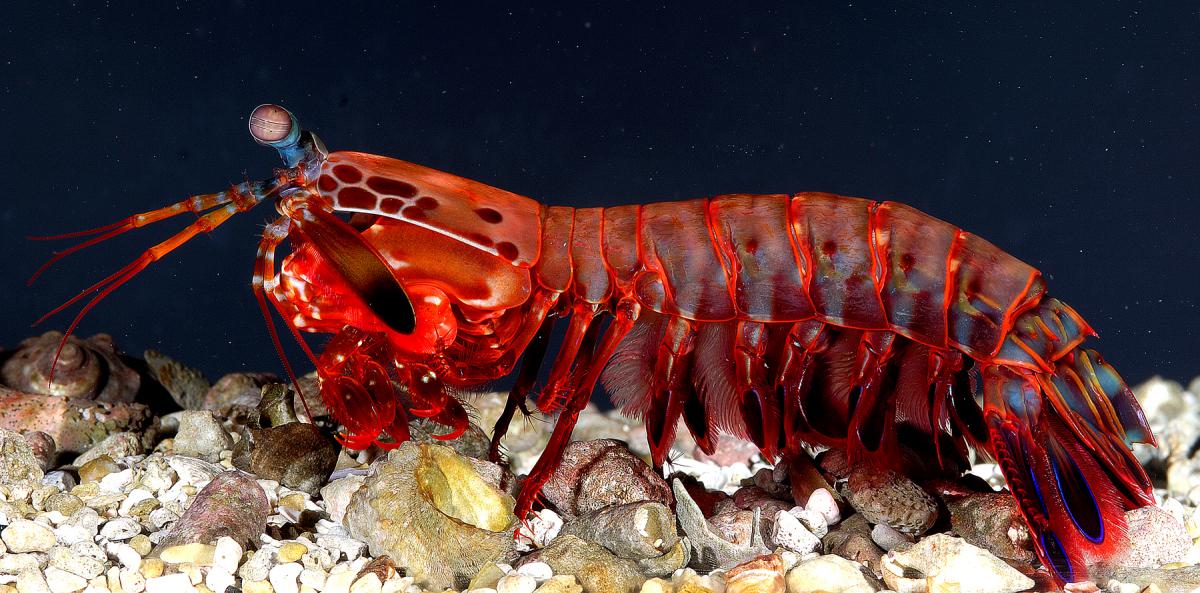Panda Ant

Well, it is a wasp actually. A furry one, which looks suspiciously like a panda. They are part of the Multillidae family. It consists of about 3000 kinds of wasps. Insects are numerous(and interesting) like that. Despite their cuteness, they wear the name “cow-killer” proudly. Yes, they can knock out a cow, imagine what they’ll do to us weak humans. They were found in Chile, in the dry desert. Nowadays their habitat includes Mexico and the USA. It is hard to observe, but the males and females are vastly different with the males being much larger. You can’t even realize they are from the same species until you see them mating.
Bush Viper

Hey, what a colorful snake, it must be poisonous! And indeed it is, very much so, fully deserving of the viper name. It lives in Africa and is not a very large reptile, only about 78 centimeters long. What makes it particularly creepy is the head. It is triangular and noticeably bigger than the rest of its body. It can also be covered in small spikes. The snake loves to hang from a branch on its tail and descend on its victims – small lizards, rodents and frogs. It is pretty, so many snake lovers take care of it as a pet.
Saiga

The Saiga antelope was once numerous throughout Eurasia and even North America. It has some very distinctive characteristics, like its nose, which is big and makes the creature funny at best and ugly at worst. They are also famous for their reproductive ability. Unfortunately they were hunted down because of their horns. They disappeared from Romania and Moldova first, then China. Finally only some thousands remained in Kazakhstan, Russia and Mongolia. Nowadays they are under protection. One of the reasons the Saigas were hunted so much was because their horns had “mythical” aspects to them(and indeed they look like two carrots sticking on their heads). No wonder the poor animal is in such great perils today.
Giant Isopod

This seabed dwelling creature is a bit hard to describe. It has a thick shell on top and numerous legs on the bottom of its body. It is not an insect, instead it is related to shrimps and crabs. Deep down must be very cozy because they can get real big, up to 36 centimeters in length. Giant Isopods usually feast on dead animals, falling from above, but sometimes they can try eating slow moving and living prey. And when they eat, they eat a lot, until they clean up everything but the bones. Another interesting thing are their eggs, which are big and spawn out a similar big “baby” .
Glass Squid

Glass Squids are survivors. Their first line of defense is, as its noted in the name, their transparent body. It provides a good camouflage, especially when combined with the pigment-filled cells inside of them. Further, they can make use of bioluminescence, aka they can glow while swimming, which only adds to their elusiveness. The light will cancel out the shadow, making them super hard to find. The chemical reactions inside of their bodies make them balloon-like and able to float, while their short arms are perfect for a surprise attack.
Nautilus

This relic from the past is still alive and kicking, and ever so creepy. The Nautilus can be described as an intricate shell with a bunch of tentacles on its end. They are spending their time deep down, close to coral rifts. When they get hungry, they start hunting down crabs and fish in shallow waters. Their movement is very interesting. What they do is sucking up ocean water, which goes inside the many chambers of their shell. Once they’ve extracted the salt, they let it all go, pushing themselves into the other direction. 500 million years of existence have proved that this method is very reliable.
Cassowary


This is a bird you definitely don’t want to meet. Living in New Guinea and Australia, it is surpassed only by the emu and the ostrich when it comes to size. And they are aggressive. Very very aggressive and almost always looking for a fight. If you have the misfortune of getting into the sights of one of them, you can expect an attack from three sides. The bird has strong legs, obviously, with a nasty blade to slice you with. They also have a blade on top of their heads. And of course the beak. Just run away and hope for the best!
Surinam Toad

There is one thing this South American toad is famous for – the way it gives birth. From its back! No really, after the act is done they imbed up to 3-10 eggs into their backs. They carry them around, meanwhile the eggs sink in, form pockets and the tadpoles grow inside. Then comes the big release, the small frogs get out of the back of their mommy in something you can call strange, or disgusting. Well, it works, so….
Coconut Crab

Meet the biggest land crabs! Yes, the Japanese Spider Crab is technically bigger, but since he lives underwater he doesn’t count. Coconut Crabs can grow to be 1 meters long and to weigh 4 kilograms. Despite their size they don’t strictly hunt other, smaller crabs. Their most delicious treat are coconuts. They can break them without much of a problem, just look at their claws. Unfortunately their numbers have dwindled after being hunted by humans, and later on by rats. Nowadays they are rarely seen on small islands in the Pacific and Indian ocean.
Pangolin

You can easily spot this interesting animal because of its unique scales. Since it moves around very slowly the scales are its only defense against predators. Maybe their best defining feature, though, is their tongue, which is the longest, when relative to their length, in the world. It starts at their pelvis for god’s sake! They use this very special tongue to suck up termites and ants, mmmmm. Different species have different size, from 30 to 100 centimeters. Despite that, they are critically endangered because of all the illegal hunting going on in Asia and Africa. Their meat and scales are quite expensive, so people take the risk.
Cuscus

The Cuscus may seem warm and cuddly at first, until you look at its face. It is triangular with big eyes and nearly absent ears. Creepy. And of course its tail and claws only add to that feel, tree life and all. Being the largest possum in the world, they are known to reach up to 60 centimeters in length. It is a nocturnal animal, which lives in Australia and Papua New Guinea. His diet includes fruits and leafs as well as small birds and reptiles. Today the Cuscus population is declining, mainly due to deforestation and being hunted for its meat and fur.

The Cyclops Shark

This is more of an anomaly than actual species. It was caught by a fishing crew near the coast of Mexico in 2011. Well, its mother actually. They caught a pregnant shark and what they found inside her was this abominable cyclopean baby. It was albino and had one big eye in the middle of its head. Scientists say that it is not all that strange to find such an aberration and the reason we don’t see more of them is because they die rather fast in the wild. Interesting.
Shoebill

Yes, this is another creepy stork living in Africa. This time it is not a
scavenger, instead this one eats fish in marshes and generally lakes, containing water with low levels of oxygen. This forces the fish to the surface and they become easy prey for the hungry bird. Shoebills are similar to storks and pelicans, except for their massive beaks. The thing looks like it jumped right out of a prehistoric movie. Not nearly as dangerous as those other ancient critters though. The most remarkable thing about the Shoebill, other than its beak, is how it pours water over its eggs to keep them cool.
Cthulhu Larva

Its other name is “Abyssal Sea Cucumber”. I know what you are thinking. Boy, this better be big and scary! No, not really. The cucumber is only a few inches long and spends its time near the ocean floor eating mud. It is still a very disturbing creature though(having no face would do that to you) and is seen a lot in almost every ocean(except for the North Atlantic). They are surprisingly tasty, so deep water fishing has reduced their numbers, especially considering how they travel around in groups consisting of 300-600 cucumbers.
Naked Mole Rat

You’ve probably heard of this one. It is obvious that fur is there for a reason, otherwise you’ll be treated to the unsightly wrinkles of an old pink skin. Combine this with their big front teeth and you might get a walrus! Anyway, these rodents are very similar to insects when it comes to their society. There is a queen, whose only job is to breed out more rats. There are workers, who dig up tunnels, other workers tend to the queen. A big happy family. Eventually they do come to the surface to look for tasty seeds. Contrary to popular belief being naked doesn’t mean you are more vulnerable. These mole rats are resistant to cancer and live up to 31 years!
Frilled Shark

It is a thing from the past, which refuses to die out. These sharks appeared about 80 million years ago and are still spotted around the world without much of a change in their anatomy. Which makes them very freakishly looking. Imagine a big eel with an even bigger head and 300 teeth inside its mouth. Yes, it is as dangerous as it is creepy looking. It seems like Australia and New Zealand are the best places to go and film some Frilled Sharks, although they are still super rare. Unfortunately humans may be the reason for the extinction of this especially stubborn fish, its numbers steadily being reduced everywhere.
Wolffish

This aptly named fish lives in the northern Atlantic and Pacific oceans. There are several species, depending on their habitat and general characteristics. One thing is for certain though, this fish is creepy! Its mainly the canine teeth, which are big and look like they’ve been taken straight out of a wolf. Other than that it is a big fish, can reach more than 2 meters in length. Even though it is certainly creepy, it is also docile and doesn’t cause problems for curious divers(unless they get too crurious).
Sea Angel

It is a transparent, ethereal being, which is a sign that angels do exist and they dwell in the oceans. Nah, just kidding, the so called “Sea Angels” are simply snails, which are populating the oceans from the equator to the poles. The ones living in colder waters are noticeably bigger, still reaching only 5 centimeters in length. As most of the other sea creatures, the Sea Angels sometimes group up and present us with a true otherworldly sight. Don’t forget to check for their horns, this is the telltale sign that they are indeed snails.
Lesula

It is quite rare to find a new monkey species in Africa but here you go, the Lesula was discovered in 2007 and is, obviously, creepy looking. It has something that can only be described as an owl face, can be seen as very chill looking too if you are not bothered by it. Unfortunately the poor primates have been hunted for a long long time. Their habitat in Congo, while recently discovered, also has little of the Lesulas left. Guess scientists got lucky and can finally take actions to keep another animal from unnecessary extinction.
Trogloraptor Spider

It is a new kind of spider, discovered in USA, something that hasn’t happened since the 1890s. Also called Cave Robber Spider, it was discovered in caves in Oregon and is not that small at all, its leg span can reach over 7 centimeters. Curious how it kept itself hidden for so long. Apart from being big and orange creepy crawler with very long legs, the way it hunts for smaller insects is also quite disturbing. It hangs upside down from the ceiling on some of its web and simply grabs whatever comes underneath. Kind of like Batman. Hmm, now we know how it managed to stay hidden.
Star-Nosed Mole

You are forgiven if you think this is some sort of a strange alien thing. It is all about the nose when it comes to this mole, the rest of its body is perfectly normal. Too bad the nose is the first thing you see. It is more like a bunch of fingers, twenty something pink and fleshy appendages strapped on its head, which help the creature find its way underground. They are quite adept at detecting seismic vibrations. Other pointless facts, Star-nosed moles live in the North East USA and Canada, their body is 20 centimeters long and weighs 55 grams.
Okapi

There is a certain type of animal in Congo, Africa. It looks like a zebra but it is closely related to the giraffes. Its ears and tongue are the two main clues to its origin, so you’ll be forgiven if you made a mistake. The Okapi is a very interesting animal, but scientists didn’t know it even existed before 1900. Obviously this was bad because its numbers kept dwindling until they reached 25 000. Currently it is under protection. They eat tasty leaves, similar to the giraffe’s diet, weigh 350 kilograms and are 150 centimeters tall.
Thorny Devil

Australia again, this time it is a lizard with a number of protective gear and tricks. The so called Moloch lives in the desert, it is about 20 centimeters long and is covered in spikes. You think this is enough? Not even one bit, the lizard also can change its color, can puff its body to appear bigger and has a false head on its shoulder. The bump there is used as a last resort to trick predators into biting where it doesn’t really hurt. Despite all this protection, they are still very vulnerable to extreme cold and hot weather, so they spend the more problematic months in their burrows.

Blue Parrotfish

A bright blue parrotfish with a yellow spot on its head, which disappears with age. No, really, their heads and mouths do make them look like parrots, however they also have another, more important function. The Blue Parrotfish spends its time chomping on rocks and corals for algae, this is why it looks so interesting. It pays off too, they can grow to up to one meter and twenty centimeters in length and are generally not in any danger as of now. Of course the more we destroy coral reefs, the worse for them.
Pacu Fish

Piranha’s little known cousin has its very own nasty reputation. It is about 90 centimeters long and weighs 25 kilograms, enough to cause a problem for anybody swimming in the Amazon. Then again, if you are swimming there you are probably asking for it. The Pacu’s teeth resemble human’s in a very disturbing way. It feeds on tree nuts, but since it is omnivorous the human flesh is also a fair game. Especially the balls. Testicles would fit very nicely in their mouths so beware!
Mantis Shrimp

Mantis Shrimps are perhaps the most badass shrimps in the world. There is a hefty number of them, all different kinds with the biggest ones growing up to 46 centimeters. They are lightly armored, having armor plates only on the head and top of their bodies, but
this doesn’t stop them from being fierce predators and even dangerous to humans. They aren’t called “thumb splitters” for nothing, be extra careful when handling them. Mantis Shrimps are also know to break aquariums with their powerful claws. That said, they are quite pretty to look at. Aquariums, remember?

Thorn Bug

As its name suggests, this big has mastered the art of looking like a thorn. It is not that big, only about half an inch in size and green/yellow in color. You can see many of them on a plant and don’t even realize they are in fact another organism. Predators naturally don’t try to eat them because what is the point? You don’t want to pierce your own throat and stomach. All that being said, they are pests. Thorn bugs suck on that sweet plant juice and make it weaker in the process. If you find them on your property, destroy them without mercy.
Penis Snake

Another brilliant name for a creature, which resembles something funny. Truth is, it is not even a snake but a limbless amphibian, which looks like an earthworm. It is rare and found only recently during a dam construction in the Amazon. Later on another bunch of penis snakes were found 2 500 kilometers away, near the mouth of the Amazon river. It doesn’t seem like the creature ever leaves water. It doesn’t have lungs so it breaths through its skin. Small fish and worms are their prey. They have a very poor eyesight and use smell instead to the waters.
Goblin Shark

Although it has been seen in almost every ocean, the Goblin Shark is a rare sight. It has a very unusual look and color. Its snout is long and very pointed, perhaps containing some sort of sensors inside. Its jaws can protrude and its tail fin is quite asymmetrical. On top of that the Goblin sharks are pink. No wonder they are the stuff of nightmares. Despite its very unusual look the shark seems to be harmless to humans, although it may be because it is so rare.
Geoduck

It may not be overly obvious at first but the Geoduck is in fact a clam. The largest clam in the world that is. Their shells reach up to 20 centimeters but the biggest attraction is their “neck” . It can go up to 1 meter, way out of home. Needless to say they are harvested for food in the Northwest Pacific, Japan especially pays good money for them. Aside from being huge and weird the Geoducks also live for a long long time, up to 168 years, clearly surpassing the humans in this regard.

Leave a Reply